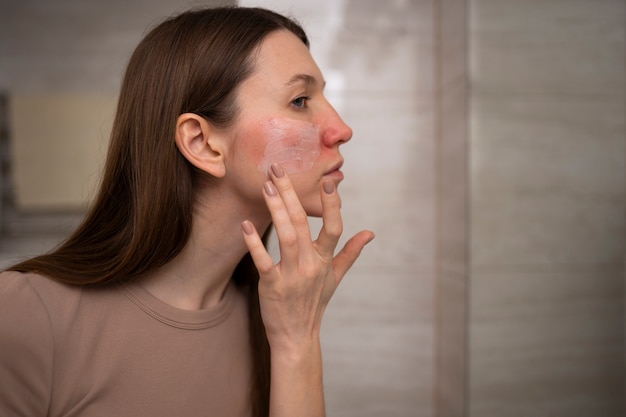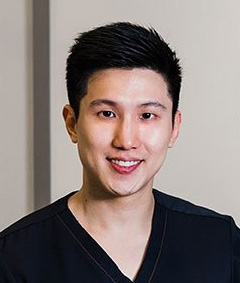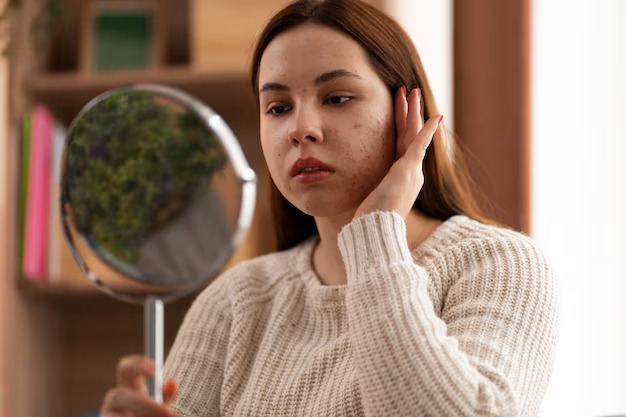Hormonal acne, a common term that refers to breakouts caused by acne hormonal imbalance, is a concern that affects many individuals, particularly during their adolescent years. However, it’s not limited to teenagers only; adults can also experience this form of acne. Understanding and addressing hormonal acne is crucial as it impacts physical appearance and can significantly affect self-esteem and overall mental health. This article aims to shed light on the causes, treatments, and preventive measures for hormonal acne, enabling you to manage, if not entirely eradicate, this skin condition.
Contents
- 1 What is Hormonal Acne?
- 2 What are the symptoms of hormonal acne?
- 3 How do Hormones Affect the Skin?
- 4 Who is Prone to Hormonal Acne?
- 5 How Common is Hormonal Acne?
- 6 Causes of Hormonal Acne
- 7 How to Treat Hormonal Acne?
- 8 How to prevent Hormonal Acne?
- 9 How Long Does Hormonal Acne Last?
- 10 When to seek a dermatologist or doctor to treat my hormonal acne?
- 11 How do you treat scars due to hormonal acne?
- 12 Conclusion
What is Hormonal Acne?
Hormonal acne is closely tied to hormonal fluctuations during puberty and menstrual cycles. These fluctuations trigger excess sebum production, clogged pores and acne breakouts. Unlike common acne, hormonal acne primarily occurs on the lower face, particularly the chin and jawline, and forms deep, painful cysts or nodules. Recognising these distinctions is crucial for a reliable acne treatment now.
What are the symptoms of hormonal acne?

Hormonal acne manifests as red, swollen, painful bumps, often in large cysts or nodules. It tends to appear on the lower half of the face. Consulting a skin specialist for an accurate diagnosis and treatment is strongly advised.
How do Hormones Affect the Skin?
Hormones play a significant role in skin health, particularly regarding acne development. Androgens, like testosterone, increase during puberty and specific menstrual cycle phases. They stimulate sebaceous glands to produce more sebum, a natural skin oil.
However, excessive sebum can block pores, creating an environment conducive to acne-causing bacteria. For example, hormone levels fluctuate during puberty, increasing sebum production, oily skin, and acne breakouts. A similar process occurs in adult women before menstruation, with a surge in testosterone levels leading to acne.
Understanding these hormonal patterns is vital for both treating acne and preventing hormonal acne. It enables early recognition of breakout signs and proactive measures to prevent severe acne and long-term skin damage.
Who is Prone to Hormonal Acne?
Hormonal acne does not discriminate; it can affect individuals of any age or gender. Nevertheless, some factors increase its likelihood. Adolescents experiencing hormonal fluctuations during puberty are particularly susceptible. Women are also prone, especially during life stages marked by varying hormone levels, such as menstruation, pregnancy, and menopause.
Other contributing factors include a family history of acne, indicating a genetic predisposition, and certain medical conditions like polycystic ovary syndrome (PCOS) and other hormone-related disorders.
How Common is Hormonal Acne?
Hormonal acne is most common among two distinct age groups: teenagers and adults in their 20s to 50s. This aligns with significant hormonal shifts during puberty, menstrual cycles, pregnancy, and menopause.
Hormonal acne affects about 50% of women aged 20 to 29 and 25% aged 40 to 49. In men, hormonal acne tends to peak in the teenage years and early 20s, with a reported prevalence of around 43%.
These statistics underscore the significant impact of hormonal acne on various age groups, highlighting the importance of understanding its causes, symptoms, and treatment options.
Causes of Hormonal Acne
Hormones play a crucial role in acne formation. However, various factors can exacerbate hormonal imbalances, contributing to the development of acne. These include the following:
Common Triggers
Acne is closely linked to two hormones: androgens (such as testosterone) and endrogens. Androgens, especially during puberty, increase sebum production and create an environment for acne-causing bacteria to thrive. Elevated androgen levels before menstruation can lead to acne breakouts in adult women. Conversely, estrogens generally help reduce sebum production, resulting in clearer skin.
However, when estrogen levels drop relative to androgens, like during the week before menstruation or menopause, acne can surge. Understanding these hormonal interactions is vital for effectively managing and treating hormonal acne.
Menstrual Cycle and Acne Flare-ups

The menstrual cycle involves many hormones that can impact acne. Women often experience breakouts before menstruation, known as ‘cyclical’ or ‘menstrual’ acne. The cycle has two phases: the follicular phase, starting from menstruation until ovulation, and the luteal phase, starting after ovulation until the next period. During the follicular phase, estrogen levels rise, leading to clearer skin. In the luteal phase, estrogen levels decrease while progesterone and testosterone remain constant, causing increased sebum production and acne. Progesterone can also lead to water retention, swelling pores, and dead skin cells, creating an ideal environment for acne-causing bacteria.
Polycystic Ovary Syndrome (PCOS)
Polycystic Ovary Syndrome (PCOS) is a hormonal disorder affecting women of reproductive age. It is characterised by elevated levels of androgens, leading to symptoms such as hormonal acne. PCOS is linked to hormonal acne due to the overproduction of androgens, which stimulate excessive sebum production and pore blockage. Insulin resistance, common in PCOS, can further worsen acne by triggering increased androgen production. Hormonal acne in PCOS often presents as large, inflamed cysts on the lower face, jawline, and neck and can be more severe and persistent than typical acne.
Hormonal Changes in Pregnancy
Pregnancy triggers hormonal changes that can contribute to acne. Increased progesterone and estrogen levels during pregnancy stimulate sebaceous glands, producing excess sebum and clogged pores. This creates an environment for acne-causing bacteria. Responses to these hormonal changes vary, with some experiencing flare-ups while others see improvement.
Pregnant individuals should be cautious with acne treatments due to potential risks to the baby. Over-the-counter topical treatments with benzoyl peroxide and glycolic acid are generally safe but consult a healthcare provider first. Maintain a consistent skincare routine, cleanse gently twice daily, and avoid picking or squeezing acne lesions—a healthy diet and hydration support overall skin health.
Increased Androgen Levels
Androgens, like testosterone, play a vital role in sebum production, contributing to acne development. These hormones stimulate the sebaceous glands to produce sebum, an oil that lubricates and protects the skin. Normally, sebum maintains skin health. However, elevated androgen levels can lead to excessive sebum production, making the skin oily. This can also disrupt the skin’s natural process of shedding dead skin cells and causing blockage in the pores known as comedos.
Certain medications
Certain medications can disrupt hormonal balance and exacerbate acne. Here are some common ones:
Corticosteroids: These drugs, or steroids, are often used to treat inflammatory conditions. However, they can stimulate the sebaceous glands to produce more sebum, leading to acne. Prolonged use of corticosteroids can also result in ‘steroid acne’, characterised by small, monomorphic papules.
Lithium: In treating bipolar disorder, lithium can cause several skin reactions, including acne. The exact mechanism remains uncertain, but it is believed that lithium may increase the inflammatory response, promoting the formation of acne.
Antiepileptic drugs: Certain antiepileptic drugs, notably phenytoin and carbamazepine, have been associated with acne. These medications can induce acne by increasing skin cell proliferation and promoting conidiogenesis.
Androgenic Steroids: These are used for various medical conditions and performance enhancement. They can increase sebum production, producing acne, particularly in genetically predisposed individuals.
Immune suppressants: Medications like cyclosporine and tacrolimus, used to suppress the immune system in conditions like autoimmune disease or post-transplant care, can cause acne as a side effect.
Vitamin B12 supplements: Though not a medication, excessive intake of Vitamin B12 can lead to acne. This is due to B12’s interaction with the skin’s bacteria, altering their metabolic pathways and promoting inflammation.
Hormonal Shifts in Men
During puberty, the surge in androgens stimulates sebaceous glands to produce more sebum, leading to an increased likelihood of acne. Stress, hormonal imbalances, and certain medical conditions can trigger hormonal acne in adult men. Androgenic steroids used for bodybuilding can also contribute to acne development. Treatment for hormonal acne in men may involve topical treatments, oral medications, and lifestyle modifications. Consulting with a healthcare provider is crucial for the appropriate management of adult acne.
How to Treat Hormonal Acne?
Treating hormonal acne typically involves a combination of topical and oral medications, lifestyle changes, and overall skin health support. Here are some commonly used methods:
Topical Treatment

Topical treatments are directly applied to the skin and are often the first choice for mild to moderate acne. Common topical medications to treat acne include retinoids, salicylic acid, and benzoyl peroxide.
Retinoids: Tretinoin and adapalene, derived from vitamin A, regulate skin cell turnover, unclog pores, and reduce inflammation.
Salicylic Acid: Exfoliates inside and on the skin’s surface, reducing swelling and redness while unclogging pores.
Benzoyl Peroxide: Fights acne inflammation by peeling skin and unclogging pores.
These treatments may cause dryness and irritation, so starting with lower concentrations and using them as part of a consistent skincare routine is essential.
Oral Medications
Birth Control Pills: Often used to treat hormonal acne in women, they contain synthetic estrogen and progesterone, reducing sebum production and acne.
Anti-Androgen Medications: Medications like spironolactone block androgen receptors, reducing sebum production.
Antibiotics: Used to combat acne-causing bacteria and inflammation. These treatments may have side effects, so consulting a healthcare professional is advised.
Lifestyle Changes and Diet
Maintaining a balanced diet and adopting a healthy lifestyle are crucial for effectively managing hormonal acne. Eating various fruits, vegetables, lean proteins, and whole grains provides essential nutrients for maintaining healthy skin. It is highly recommended to avoid consuming high-glycemic-index foods like processed and sugary snacks, as they can exacerbate acne. Staying hydrated and exercising regularly are also vital for managing hormonal acne. In extreme cases, medical treatment may be required. For personalised advice, it is recommended to consult a healthcare professional.
Natural Remedies and Supplements
Natural remedies and supplements can complement the battle against hormonal acne, offering a holistic approach to skincare. They address the root causes of acne from within:
Tea Tree Oil: Known for its antibacterial properties, it can be used as a natural remedy for hormonal acne.
Green Tea: Antioxidant-rich and anti-inflammatory properties, green tea benefits hormonal acne both topically and when consumed as a beverage.
Herbal Supplements: Vitex (chasteberry), saw palmetto, maca root, omega-3 fatty acids, and adaptogens like ashwagandha can help balance hormones and manage acne.
How to prevent Hormonal Acne?
Preventing hormonal acne requires a combination of skincare and lifestyle adjustments. Here are practical tips:
Have a consistent skincare routine.
Do regular exfoliation
Hands off your face
Have a healthy diet.
Stay hydrated
Regular exercise
Manage stress
Get adequate sleep
Avoid popping Pimples
Skincare Routine
Consistency is key for effective skincare. Follow this routine tailored for acne-prone skin:
Cleansing: Clean your face twice daily with a gentle, non-comedogenic cleanser.
Toning: Apply a non-comedogenic toner to balance your skin’s pH.
Exfoliation: Exfoliate 2-3 times a week with a non-comedogenic exfoliator.
Serum (optional): If you use a serum, apply it after toning, exfoliating, and moisturising.
Moisturising: Even if your skin is oily, apply a non-comedogenic moisturiser.
Sunscreen (Daytime): Protect your skin with a broad-spectrum, non-comedogenic sunscreen.
Non-comedogenic Skincare Products for Acne-Prone Skin
When choosing skincare products, look for the term ‘non-comedogenic’. This means the product is formulated to not clog pores, reducing acne risk. Here’s a list of specific non-comedogenic products suitable for acne-prone skin:
Cleanser: CeraVe Foaming Cleanser
Toner: La Roche-Posay Effaclar Clarifying Solution
Moisturiser: Neutrogena Oil-Free Moisture
Sunscreen: EltaMD UV Clear Broad-Spectrum SPF 46
Exfoliator: Paula’s Choice Skin Perfecting 2% BHA Liquid Exfoliant
Stress management
Stress significantly affects skin health, especially hormonal acne. Stress triggers excess cortisol production, increasing sebum production and acne breakouts. It can also cause inflammation, worsen skin sensitivity, and impede healing.
Addressing stress is vital for managing hormonal acne. Try these methods to reduce stress:
Regular Exercise: Exercise boosts endorphins, improving mood and regulating hormones.
Mindfulness and Meditation: Incorporate mindfulness practices into your daily routine.
Balanced Diet: Consume whole foods and avoid high-sugar, processed items.
Quality Sleep: Aim for 7-9 hours of sleep each night.
Social Connection: Spend time with loved ones for emotional support.
Healthy Diet

A healthy diet is closely linked to skin health and hormonal acne. Foods can impact inflammation, insulin levels, and hormonal balance, affecting acne development.
A diet rich in fruits, vegetables, whole grains, and lean proteins can help maintain skin health and reduce the risk of hormonal acne. These foods provide essential nutrients, antioxidants, and anti-inflammatory compounds that promote optimal skin health.
Whole Grains: Include oats, brown rice, and barley.
Fruits and Vegetables: Opt for berries, oranges, bell peppers, and leafy greens.
Lean Proteins: Choose fish, poultry, tofu, and legumes.
Healthy Fats: Incorporate avocados, nuts, and seeds.
Hydration: Drink plenty of water to support skin health.
Certain foods may trigger acne in some individuals, including dairy products, high-glycemic-index foods, and processed items high in trans fats and artificial additives.
How Long Does Hormonal Acne Last?
The duration of hormonal acne varies based on hormone levels, stress, diet, and skincare. A breakout typically lasts a few days to two weeks. It may appear monthly with the menstrual cycle. In persistent cases, it can last for years if untreated. It can start in adolescence or adulthood. Effective management of inflammatory acne involves suitable skincare, a healthy diet, stress management, and sometimes medical treatments.
When to seek a dermatologist or doctor to treat my hormonal acne?
While some mild acne or to moderate acne can be managed at home, certain signs indicate the need for professional help from a dermatologist or doctor if:
Your acne doesn’t improve after 5-8 weeks of consistent self-care and over-the-counter treatments.
You have severe acne, such as nodular or cystic acne.
Your acne leaves scars or hyperpigmentation.
Acne significantly affects your emotional well-being.
How do you treat scars due to hormonal acne?
If you’re dealing with persistent acne that is leaving behind unsightly scars, it’s essential to consider seeking acne scar treatment from a dermatologist or doctor. Acne scars, including ice pick, boxcar, and rolling scars, can impact your self-esteem and overall skin appearance.
Professionals can assess your unique skin condition, recommend tailored treatment options, and help you achieve smoother, more even skin.
Early intervention is often key to minimising the long-term effects of acne scars, so don’t hesitate to consult with a skincare professional to explore effective solutions for scar reduction and improved skin texture, tailored to your specific needs.
Conclusion
Hormonal acne is a complex skin condition influenced by various factors, including stress, diet, hormonal imbalance, and insufficient sleep. It’s essential to know that managing this condition isn’t solely about skincare routines but also involves a holistic approach towards health and lifestyle. Incorporating regular exercise, a balanced diet rich in antioxidants and lean proteins, and practising mindfulness can significantly help reduce stress and regulate hormones. Remember to stay hydrated and aim for quality sleep to support overall well-being and skin health.
If your acne persists or severely affects your emotional health, don’t hesitate to seek professional advice.





